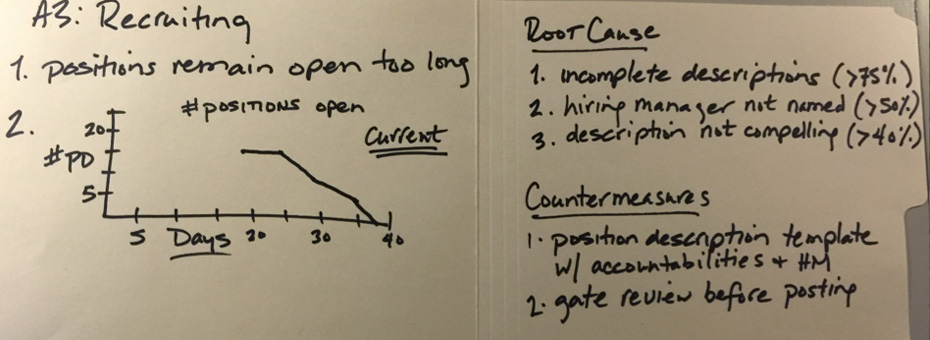A3 thinking can be applied to solve many different problems in the workplace – but recruiting problems might not be the first that come to mind. The Lean Post recently sat down with Gavin Martin to hear his story of introducing A3 thinking to solve a costly recruiting problem at his organization.
What was the recruiting problem that necessitated using A3 thinking?
We had a lot of open positions that we just couldn’t fill. The number just kept growing, and that was a big problem for us because a lot of these positions had been authorized by our clients. So that meant lost revenue every day the positions remained open.
Why did you decide to use A3s to fix this?
Originally the recruiting manager used spreadsheets and his Gmail account to keep track of open positions. So he’d know generally what positions were open, but it was hard for him to keep track of everything. That didn’t give us a great base from which to start problem-solving. I recommended A3s because I’m very familiar with them and I’ve used them to problem-solve successfully in the past. I explained to him that an A3 is not so much a “silver bullet” as a way of thinking about what the problem is and then formulating a hypothesis to achieve an outcome you think you’re looking for. He had never even heard of an A3 before, but he was open to innovative techniques.
So since the recruiting manager had no familiarity with A3s and the problem was his to own, how did you two go about setting it up?
I coached him through the process and we also went through the Five Whys together to get to the root of the problem. My goal was to mentor him. An A3 is meant to spark a meaningful discussion between myself and someone with whom I am working, rather than me just telling them, “Do this. And that. And that.” That’s not mentoring – that’s directing; and directing does not scale, nor does it contribute to someone’s professional development.
Let’s go deeper into the A3 itself. What was the goal you wanted to achieve?
To hire more “A-Players” (someone in the top 10% of the available talent pool who is willing to accept our specific offer), reduce hiring-cycle time to no more than 10 days, and contribute to revenue growth.
What was your assessment of the current situation?
We came up with several things. We had:
- No pipeline of candidates
- Lost revenue from open positions
- Reactive recruiting allowing for the possibility of “poor fits”
- Ad hoc “process”
- Incomplete position descriptions causing “back and forth” between recruiting and managers
- No clear definition of our ideal candidate
And from there, what did you find was causing the problem of positions taking too long to fill?
Several things, but the biggest was that there was a lack of standardization in our recruiting process. We needed a mechanism by which to articulate accountabilities of a specific role and information about the work environment (e.g., customer, team, engagement details) and the compensation package in the job descriptions. We also needed a way to assess candidates relative to their peer group’s size and talent that was substantial enough to allow for the application of selection criteria.
What countermeasures did you implement?
We adopted the Topgrading methodology. This helped us identify our ideal candidate (the A-Player). Topgrading uses a “job scorecard” for writing detailed job descriptions and that became our template. We decided that future job descriptions would contain information about each position’s accountabilities, work environment, compensation package, hiring manager, a compelling purpose and vision, and the company’s core values. We also implemented gate reviews to happen before positions are posted to prevent incomplete submissions. And we recognized that employee attrition, though not directed correlated with open positions, is still indicative and should be measured and tracked.
What results have you seen so far since the A3 analysis?
For one, it’s been reported to me that the number of back-and-forth emails between recruiters and managers regarding position descriptions has been reduced to one-twelfth of what they used to be. That came from both our newly standardized job descriptions and gate reviews. Our new job descriptions have helped us attract A-Players for positions. Now, rather than the 50+ resumes we used to get for open positions, we get about 10; and of those 10, around 7-8 will have pre-qualified themselves because SeKON’s purpose resonates with them, they align with our values, and accept the accountabilities of their prospective job – all of which we started putting in the job descriptions.






As a fellow lean leader, I am encouraged to read how A3 thinking is being leveraged in the recruiting industry. I am looking for support materials to share how A3 problem solving is a universal lean tool and a way of thinking that can be applied in any industry.